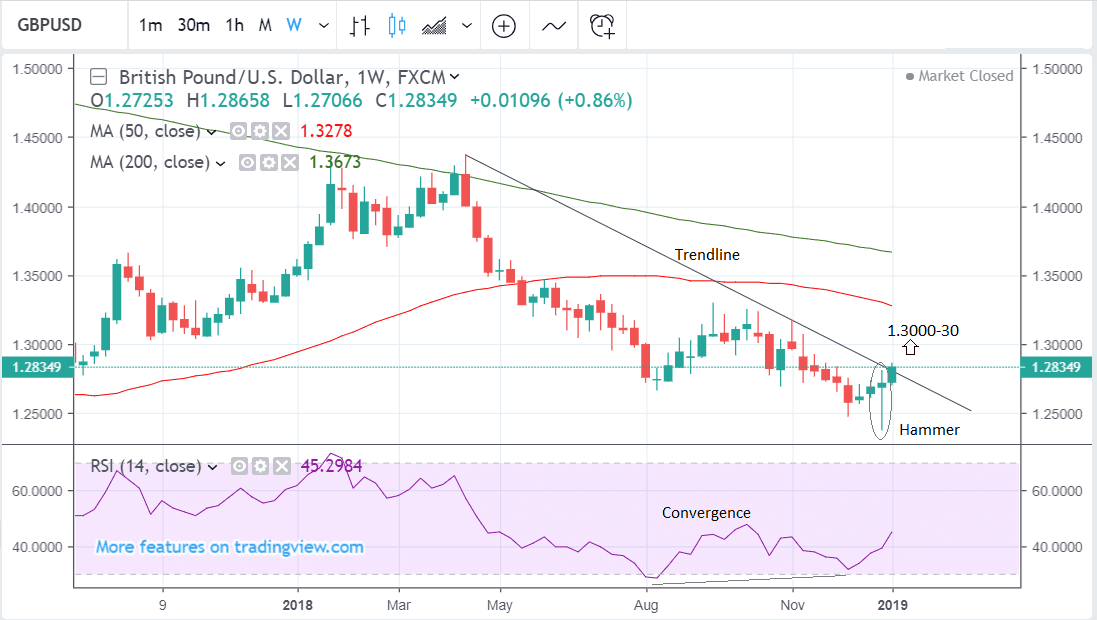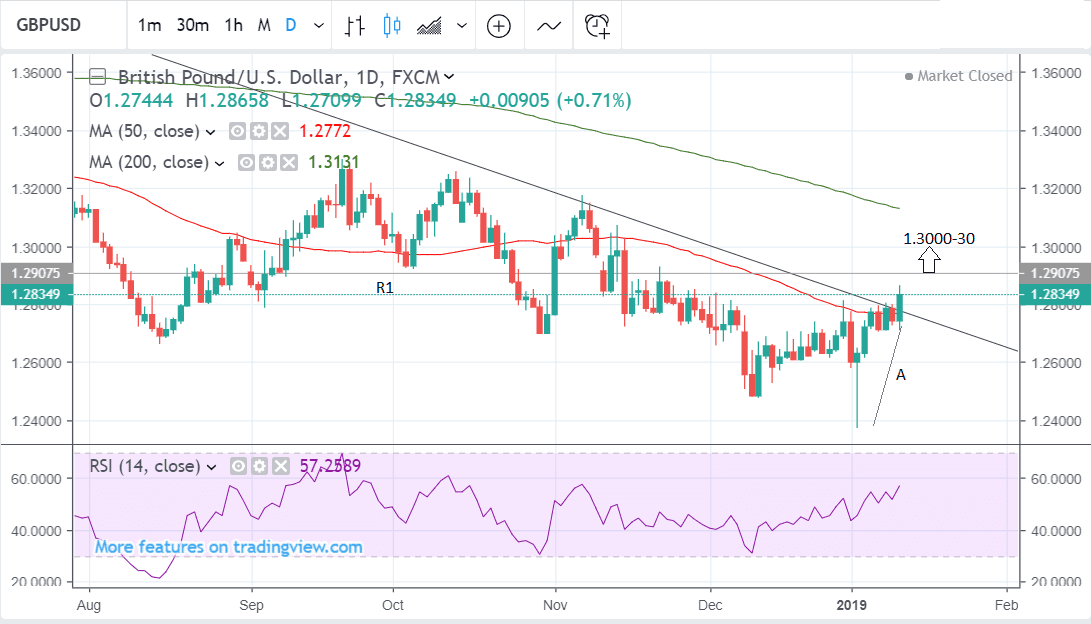Pound-to-Dollar Rate 5 Day Outlook: Break Above Trendline Sets Up Bullish Week Ahead, Brexit Vote is Key Risk

Image © Adobe Images
- Bullish signal after GBP/USD breaks above trendline
- Possibility of rise to 1.30 on the cards
- Main event for Sterling is Brexit vote; for Dollar retail sales
The Pound is positively aligned against the Dollar from a technical perspective and could climb higher, but we are wary of the implications of this week's Brexit vote for Pound Sterling.
The Pound-to-U.S. Dollar rate is quoted at 1.2835 at the start of the new trading week, after rising over 0.86% in the week before, taking the Pound's advance on the Dollar in 2019 to 0.6%.
Most of the gains in the GBP/USD pair are a result of a broadly weaker U.S. Dollar stemming from improvements in global investor appetite, expectations for slowing U.S. economic growth and the ongoing government shutdown.
The Pound gained marginally as probabilities of a ‘no-deal’ Brexit receded even further after the government lost a key Brexit finance bill in the commons. It then gained further ground after rumours the Brexit deadline itself might be delayed in the event of Theresa May's Brexit deal being voted down.
The Brexit vote on the government’s withdrawal bill in Parliament is certain to cause volatility in the week ahead when it is held at 19.00 on Tuesday.
From a technical perspective, the Pound is looking increasingly bullish against the Dollar.
The weekly chart shows the formation of a bullish Japanese hammer candlestick in the week before last, and then a bullish up-week to follow, which provides added confirmation. This is a fairly reliable short-term bullish signal for the pair.
GBP/USD has rallied quite strongly up from the January 3 lows and has now also broken clearly above a major trendline drawn from the April 2018 highs. This break on both a weekly and daily closing basis reinforces the bullish short-term trend and makes more likely a continuation higher in the week ahead.
The move higher after the break of the trendline could extend to as high as 1.3000-30, based on the height of the move prior to the trendline (A) extrapolated higher.
The RSI momentum indicator in the bottom panel is also bullish as it is trading at the same level it was at when the exchange rate was above the 1.30s back in November. This may suggest ‘pent-up’ unexpressed upside which could come out in the week ahead.
A break above the 1.2910 level would probably provide confirmation of more upside to a target at between 1.3000-30.
Advertisement
Bank-beating exchange rates. Get up to 3-5% more foreign exchange by using a specialist provider to get you closer to the real market rate and avoid the gaping spreads charged by your bank when providing currency. Learn more here
The U.S. Dollar: What to Watch
The U.S. Dollar has struggled in 2019 with an improvement in global investor appetite appearing to be a large driver of the weakness.
Should this optimism characterise market trade over coming days then the trend lower in the U.S. Dollar could extend.
The domestic backdrop remains challenging for the U.S. unit as political uncertainty drags on thanks to the ongoing partial government shutdown while the Federal Reserve grows increasingly cautious about the outlook, with the Fed Chairman Powell most recently highlighting the size of the U.S. debt as a major risk factor.
On the 'hard data' front, probably the most important release for the U.S Dollar will be retail sales for December, due out on Wednesday at 13.30 GMT. This is forecast to show a 0.2% rise month-on-month, the same as the growth it showed in the previous month.
Consumer spending is a major contributor to overall growth in the U.S. economy so retail sales will be important for gauging how well the economy is holding up, especially amidst qualms it may be slowing down.
“Despite recent worries of slower domestic growth, the consumer sector looks poised to post another solid quarter to end the year,” say Wells Fargo who foresee a positive print for December in an economic note covering the coming week. “Control group sales, a proxy for personal consumption expenditures (PCE), were up 0.9%. This was the strongest monthly increase for 2018 so far, and points to another strong print for PCE in Q4.”
If retail sales remain strong they will help support the U.S. Dollar, if lower-than-expected, they will add to fears about the slowdown in the economy, and probably weaken the Dollar.
The other major release for the Dollar may well be regional manufacturing data from New York and Philadelphia, which is out on Tuesday and Thursday respectively at 13.30. This is because the market is still reeling from the sharp drop in the ISM manufacturing index registered last week and will want confirmation from the regional indicators.
“After last month’s shock plunge in the ISM manufacturing PMI, the New York Fed’s Empire State manufacturing index and the Philadelphia Fed’s own manufacturing barometer will be watched more closely than usual for potential signs the US economy could be headed for a sharp slowdown. Consensus estimates for January though, are for both indices to rise slightly.” Says Raffi Boyadjian, an analyst at XM.com.
The Philly Fed index is forecast to come out at 10 from 9.1 previously and NY is forecast to rise to 11.25 from 10.90.
Another key barometer of the economy is U.S. industrial production, out on Friday at 13.30. This is forecast to show a slower 0.2% rise in December, from 0.6% in November. Again a lower-than-expected print would shake market assumptions about the U.S. economy and vice-versa for a stronger reading.
The Pound: A Big Week for Brexit Politics
By far the most important event in the week ahead is the vote on Theresa May’s Brexit deal, scheduled for Tuesday 15, at 19.00 GMT. The outlook definitely favours the government to lose, and it is more a question of ‘by how much’ rather than ‘whether’.
The Pound's reaction will therefore likely depend on the size of the loss, and what comes next. If the loss is large - defined by a 100 or more MPs - as some analysts believe, it might signal the death of the government’s deal and could prompt a knee-jerk move lower in Sterling.
"Very few commentators expect the deal to pass, so the move in GBP would likely be limited on that news alone," says Jordan Rochester, analyst with Nomura. "But we would be looking at the size of the defeat to understand whether a repeated vote could get over the line."
The expected defeat would probably lead to a vote of no-confidence in the government, called by the Labour Party. But we don't see the government losing such a vote as the DUP and Conservative party would unite to defend their hold on power.
"We’d expect the government to win a vote of no confidence as turkeys rarely vote for Christmas," says Nomura's Rochester.
We think the government will ultimately rework the Brexit deal and bring it back to parliament for a second airing, and there is talk of some EU concessions being made available to help the deal cross the line on a second vote.
While there is a majority in Parliament who are committed to avoiding a 'no deal' Brexit, as proven by last week’s finance bill vote, there is not necessarily a majority to command an alternative plan.
Last week's reports that a large portion of Labour Party MPs are open to supporting the deal if they can secure their own changes is a significant shift in the debate we believe: if these MPs secure some changes to the deal, a softer Brexit is in sight, which represents an all-out positive for Sterling.
Last week's report the government is considering a delay to the Article 50 process is also notable in that it suggests government ministers are aware that all alternative Brexit scenarios that would follow the failure of May's deal, would need more time to formulate and execute. While the reports were officially denied by 10 Downing Street we believe this a case of where there is smoke, there is fire.
“Perhaps the best-case scenario for the Pound, barring the deal passing in parliament, would be a delay to the article 50 process. This decision would have to be agreed by the EU, however they are likely to do so, with the Pound set to appreciate due to the removal of the pressure of hitting the 29th March deadline for exiting the EU,” says Michael Brown, Senior Analyst at Caxton FX.
Brexit aside, the two main economic releases in the week ahead are inflation out on Wednesday and retail sales on Friday. Of the two, analysts think the latter is most likely to have the greater impact on Sterling.
“With the Bank of England not expected to raise interest rates unless Parliament approves a smooth Brexit, the inflation data is unlikely to have much impact in currency markets. Retail sales on the other hand could see a stronger response by traders as it’s a better gauge of UK growth momentum,” says Raffi Boyadjian, an analyst at broker XM.com.
Retail sales are forecast to show a -0.7% fall in December according to consensus estimates. If so the Pound could fall due to a drop in expected Q4 growth.
Wednesday’s inflation data, meanwhile, is expected to show a rise of 0.2% month-on-month (Mom) and 2.2% compared to a year ago, when it is released at 9.30, with little changed from the previous print. The higher the result the better for the Pound and vice-versa.
Advertisement
Bank-beating exchange rates. Get up to 3-5% more foreign exchange by using a specialist provider to get you closer to the real market rate and avoid the gaping spreads charged by your bank when providing currency. Learn more here






